This was published 7 months ago
She helped Cambodians confront Khmer Rouge killers. Now, Helen’s on a new mission
Helen Jarvis helped Cambodians confront their Khmer Rouge persecutors. Now she’s pushing to get the killing fields World Heritage-listed.
By Chris Ray
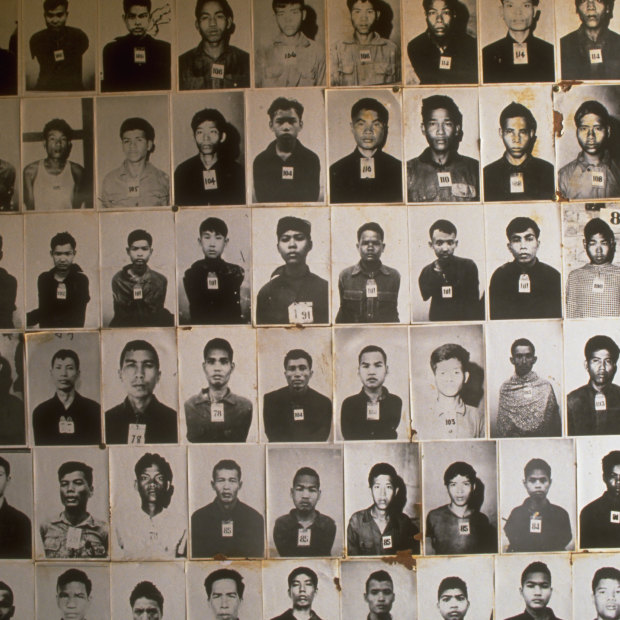
At Tuol Sleng Genocide Museum, photos document some of the Khmer Rouge victims held there.Credit: Corbis via Getty Images
On a riverbank deep in the Cambodian countryside, a former Sydney academic turned genocide investigator is probing a patch of long grass with her bamboo walking stick. Helen Jarvis is looking for more evidence of mass murder: bones or teeth, or scraps of clothing, for instance.
Half a century ago, the Khmer Rouge turned this sun-flayed stretch of sand and scrub into a prison camp and execution ground, which it code-named M-13. “People still find human remains here after all this time,” says Jarvis, a purposeful, plain-spoken 78-year-old.
M-13 is a three-hour drive from Cambodia’s booming capital, Phnom Penh, along roads lined with straggling villages of timber houses on stilts. As big as a football stadium, M-13 is bounded by an oxbow lake and a milky brown river that winds across a patchwork of newly ploughed fields. On the horizon, sapphire-blue mountains shimmer in the haze. It’s mid-year, traditionally the start of the wet season, but the south-west monsoon is yet to deliver regular cooling rain.
I join M-13’s caretaker, Nop Oun, in the shade of a bamboo grove. Jarvis, who wears a straw hat and a Palestinian keffiyeh, carries on with her site inspection despite the oppressive heat. An adviser to the Cambodian government, she’s helped prepare its submission to UNESCO, the United Nations cultural body, seeking World Heritage listing for M-13 and two other locations chosen to represent the nationwide network of Khmer Rouge interrogation and execution centres known as the killing fields. World Heritage listing would give them the international recognition afforded to monuments such as the Nazi death camp at Auschwitz-Birkenau.
Jarvis and her journalist husband, Allen Myers, live in a traditional Khmer-style timber house raised on high wooden poles beside a broad stretch of the Mekong River. A former head of library and information studies at the University of New South Wales, Jarvis had already spent a decade shuttling between Sydney and Phnom Penh when she moved permanently to Cambodia in 1999. She’s known internationally for her work researching Khmer Rouge atrocities, mapping the killing fields and helping run a UN-backed tribunal that found the Khmer Rouge leadership guilty of genocide.
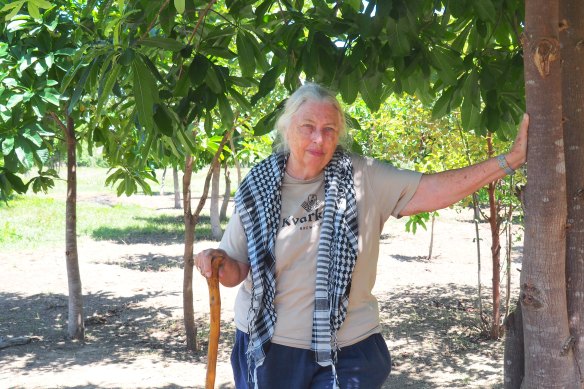
Australian Helen Jarvis is pushing for World Heritage listing of interrogation centres and killing field sites.Credit: Chris Ray
The tribunal delivered its final judgment in 2022 – 25 years after Cambodia asked the UN to help it put former Khmer Rouge leaders on trial. Three were jailed for life and two died awaiting trial or verdict. The head of the gang, Pol Pot, escaped justice, dying in murky circumstances at a Khmer Rouge hideout near the Thai border in 1998.
Khmer Rouge forces took power in 1975 after a civil war against a military dictatorship backed by the United States. The conflict included an initially secret US bombing campaign that killed as many as 150,000 civilians between 1969 and 1973, according to Australian historian Ben Kiernan, a professor emeritus at Yale University.
B-52 carpet bombing was supposed to halt the Khmer Rouge advance on Phnom Penh and devastate North Vietnamese troops moving through Cambodia to the battlefields of South Vietnam. Instead, it “destroyed rural Cambodia” and drove much of Cambodia’s peasantry into the arms of the insurgency, which expanded to more than 200,000 troops and irregulars, Kiernan says.
Pol Pot’s regime embarked on a radical agrarian revolution laced with persecution of ethnic minorities. It emptied cities, forced people into labour camps, separated families, suppressed Buddhism and closed schools. Jarvis puts the number of deaths from mass execution and physical privation at about two million – a quarter of the population.
Today, Cambodia is engaged in a nationwide effort to “better understand the roots of violence … and maintain the precious peace that has been won today,” as the country’s Minister of Culture, Phoeurng Sackona, put it recently. At the Tuol Sleng Genocide Museum – a former interrogation and torture centre in Phnom Penh and M-13 companion site for World Heritage nomination – director Hang Nisay tells me, “What happened should be remembered and never repeated.”
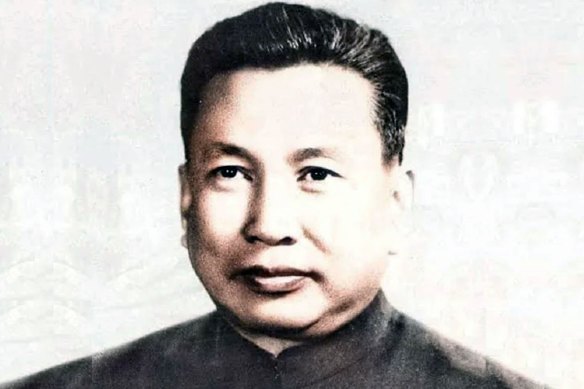
Khmer Rouge dictator Pol Pot in about 1978.Credit: Alamy Stock Photo
The Khmer Rouge terrorised Cambodia for three years, eight months and 23 days until ousted by an invading Vietnamese army and Khmer Rouge defectors in 1979.
However, Cold War politics kept it on life support and seated at the UN as a government in exile. In a coalition that seems bizarre in light of today’s alignments, China armed the perpetrators of the genocide, Thailand gave them sanctuary and the US and allies including Australia provided diplomatic cover (it took two more years, and a threat from Australia’s then foreign minister Andrew Peacock to resign from Malcolm Fraser’s ministry, for Australia to withdraw recognition of the Khmer Rouge as Cambodia’s legitimate government).
When Jarvis started working in Phnom Penh, helping the national library get back on its feet, Cambodia’s new rulers had few friends outside Vietnam and the Soviet Union. “Cambodians felt abandoned by the international community. They couldn’t believe the world still supported the Khmer Rouge,” she says.
“I had always been on the left politically and active in the anti-war movement. I got involved with a global campaign for recognition of the new government and a Nuremberg-style trial of the Khmer Rouge leadership.”
A rare conduit to the West, Jarvis became a confidante of government ministers. She has since been awarded Cambodian citizenship and three national medals.
While Jarvis was raising funds for library equipment and training Cambodians to catalogue books, Ben Kiernan launched Yale University’s Cambodian Genocide Program. Its aim was to investigate the catastrophe and help determine who was responsible.
Jarvis joined the project, which made a remarkable discovery: more than one million signed or thumb-printed witness statements and photographs testifying to life under the Khmer Rouge. They’d been collected partly as evidence for a 1979 trial of Khmer Rouge leaders in absentia that the West dismissed as a show trial. Jarvis agrees the trial had procedural flaws, “but it gathered a vast trove of evidence of how people suffered under the Khmer Rouge. The evidence was mouldering away in boxes.”
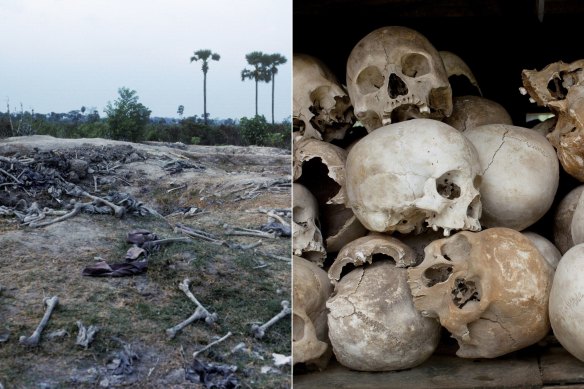
Human bones found on the killing fields in 1983 and skulls of some of the millions of victims.Credit: Getty Images
When Jarvis realised the Cambodian government had no national picture of the extent of the killing fields, she obtained Australian government funding to help create a map of the Khmer Rouge gulag. Equipped with an early GPS receiver provided by colleagues at UNSW’s engineering faculty, she launched a countrywide project that recorded the co-ordinates and details of hundreds of mass graves, prisons and memorials erected by villagers.
In 1999, the UN agreed to support a tribunal, provided it was held outside Cambodia and used only international judges. “UN administrators decided the only Cambodians allowed to play a role would be those in the dock,” Jarvis says. “The Cambodian government said, ‘The crimes were committed here. If you want to help, please do, otherwise we will do it ourselves.’ ”
She joined a Cambodian team that negotiated with the UN for three years in an effort to assert some sovereignty over the process. The result was a deal for a hybrid tribunal of local and international judges, to take place in Cambodia.
‘Cambodians wanted to stand in the courtroom, be able to look their perpetrators in the eye and ask questions such as, “What happened to my mother – or my wife?” ’
Conflict then arose over the government’s insistence that victims be allowed to participate in the tribunal as civil parties, as provided for under Cambodian law.
“UN administrators and international judges from common law countries sought to limit the role of victims to that of witnesses only,” Jarvis says. “But Cambodians wanted to stand in the courtroom on an equal basis with their persecutors. They wanted to be able to look them in the eye and ask questions such as, ‘What happened to my mother – or my wife?’ ”
The Cambodian position prevailed and Jarvis was appointed head of the tribunal’s victim support unit, which held nationwide meetings to inform people they had a right to take part. More than 11,000 people signed victim impact statements and 6875 of them were approved to participate as civil parties. “They got the right to sit in the courtroom on rotation with their own lawyer and raise questions. It was a major contribution to the development of international justice,” Jarvis says.
The trials were broadcast live on television and radio and millions of Cambodians followed them intently. Almost 245,000 people sat in the public gallery over 639 hearing days. Jarvis says the tribunal led to “a flowering of public and private reflection, research and comment” as the genocide was remembered in films, plays, dance, painting and sculpture.
The sheer number of victims made financial compensation unaffordable, but the tribunal did propose “moral and collective” reparations in the form of memorials, documentation and education, and rehabilitation. This usually takes the form of therapy sessions involving small groups of traumatised victims and/or their children.
“They meet with a counsellor and share stories in a wat or mosque,” Jarvis says. “If they are literate they write their testimonial; if not, someone writes it for them. In the wats, these are read aloud in front of an altar with incense burning and in the presence of a monk.”
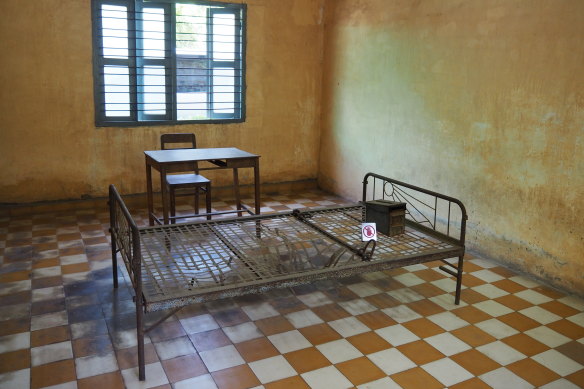
A cell at Tuol Sleng Genocide Museum.Credit: Chris Ray
Prime Minister Hun Manet has called for “genocide education” to be integrated into school history, literature, leadership and “Khmer morality” studies. Tuol Sleng Genocide Museum conducts oral history and poetry competitions and takes mobile exhibitions to the countryside, where survivors talk to students at crime scenes.
Museum director Hang Nisay says the meaning of Tuol Sleng for Cambodians has changed over time.
“At first, people came mainly in the hope of identifying missing relatives from our photographs. Parents did not encourage young people to visit because they feared it would bring bad luck,” he says. “Now, school students are eager to come to learn their history, university students come to do research and parents understand the need for education about the past.”
To read more from Good Weekend magazine, visit our page at The Sydney Morning Herald, The Age and Brisbane Times.